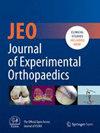Image-free robotic-assisted total knee arthroplasty is associated with joint line distalization and improves mid-flexion instability: A prospective cohort study
Abstract
Purpose
Total knee arthroplasty (TKA) has demonstrated long-term durability, with a significant reduction in revisions due to polyethylene wear and component loosening. However, mid-flexion instability (MFI) is a key factor in early TKA revisions, affecting patient satisfaction and implant longevity. Recent advancements in robotic-assisted TKA (raTKA) provide precise joint line (JL) restoration and component positioning, potentially reducing MFI. This prospective study evaluated the impact of image-free raTKA on MFI and JL restoration.
Methods
This prospective cohort study included 59 knees undergoing primary TKA using the image-free robotic systems NAVIO® and CORI® and the JOURNEY II® Bi-Cruciate Stabilized knee system. Intraoperative component gap (CG) measurements at 0°, 30°, 60° and 105° of flexion were taken, and JL changes were assessed pre- and post-operatively using computed tomography (CT)-based three-dimensional (3D) models with the 3D-3D matching technique. The distal femoral JL was quantified.
Results
Both the medial and lateral CG at 30° and 60° were significantly smaller compared to those at 0° and 105°. Post-operative JL showed distalization of 1.5 mm at the medial femur and 2.0 mm at the lateral femur compared to preoperative JL.
Conclusions
This study is the first to assess JL restoration in raTKA using CT-based bone landmarks, offering precise insights. Image-free raTKA facilitates precise JL restoration, optimizing knee kinematics and enhancing stability. These findings suggest that this technique contributes to improved post-operative joint function and greater patient satisfaction.
Level of Evidence
Level II, prospective cohort study.


 求助内容:
求助内容: 应助结果提醒方式:
应助结果提醒方式:


